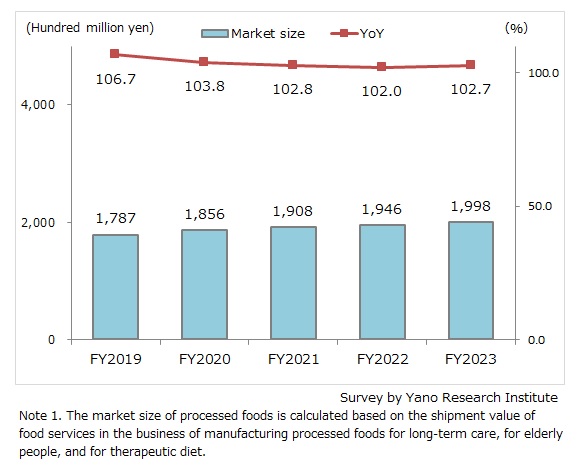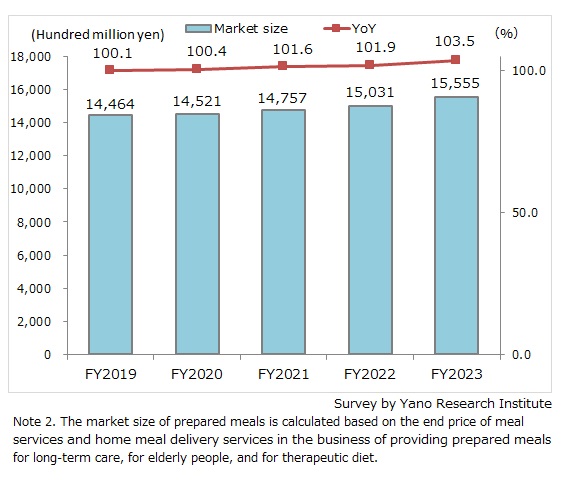No.3650
Healthcare Food Service Market (Market for Foods for Long-Term Care, for Elderly People, and for Therapeutic Diet) in Japan: Key Research Findings 2024
Healthcare Food Service Market (Market for Foods Long-Term Care & for Elderly People) Expects Stable Expansion
Yano Research Institute (the President, Takashi Mizukoshi) conducted a survey on the domestic healthcare food service market, including processed foods and prepared meals for long-term care, for elderly people, and for therapeutic diet, and found out the trends by segment, the trends of market players, and future perspectives.


Market Overview
The size of the domestic healthcare food service market (for long-term care, for elderly people, and for therapeutic diet) for processed foods in FY2023 was valued at 199,800 million yen, 102.7% of the previous fiscal year (based on the shipment value at manufacturers), and the for prepared meals at 1,555,500 million yen, 103.5% of the preceding fiscal year (based on the end price of meal services and meal delivery services). In detail, the market size of processed foods for long-term care reached 135,000 million yen (103.4% of the preceding fiscal year); prepared meals for long-term care generated 578,000 million yen (102.9%); processed foods for elderly people yielded 30,000 million yen (103.1%); prepared meals for elderly people was 386,900 million yen (104.2%); processed foods for therapeutic diet fell to 34,800 million yen (99.4%); and prepared meals for therapeutic diet attained 590,600 million yen (103.7%). Except for the market for processed foods for therapeutic diet, all markets showed year-on-year growth.
Noteworthy Topics
Fully Prepared Meals Contribute to Workforce Shortage at Healthcare Facilities
The meal service for healthcare facilities such as hospitals and elderly facilities must provide meals three times a day for throughout a year. However, operational efficiency is an issue, particularly at small-scale senior homes with small number of residents, on top of difficulties in securing caregivers.
To lessen the burden of food preparation and serving operations, healthcare facilities are increasingly using processed foods and fully prepared foods. Eying on the balance between cost and workforce status, they use ambient, chilled, and frozen foods for their daily servings. Catering to the needs for improving efficiency in food preparation at the healthcare facilities by providing a wide range of foods for all eating occasions (breakfast, lunch, dinner, and snacks) and for various type of dishes (main dish, side dish, and desserts), the food services of fully prepared meals are expanding their market steadily.
Future Outlook
Backed by the increase of older populations and single-person households, we believe the market for foods for long-term care and for elderly people will expand further. In addition, the housing situation for the elderly is likely to evolve in line with the national policies and changes in the lifestyle of the elderly people. Older hospital patients will be moved to senior care facilities, while elderly residents in those facilities will return to their homes.
On the other hand, the market for processed and prepared foods for therapeutic diet are expected to decline, due to the trend of medical professionals claiming strict protein restriction is not necessary for patients with chronic kidney disease.
The size of healthcare food services for processed foods (for long-term care, for the elderly people, and for therapeutic diet) is forecasted to expand to 221,500 million yen by FY2028, and the size of healthcare food services for prepared foods (meal services for hospitals and senior facilities, bento and other meal delivery services for long-term care, for elderly people, and for therapeutic diet) is expected to grow to 1,723,200 million yen.
Research Outline
2.Research Object: Meal service providers, home meal delivery service providers, food processing companies
3.Research Methogology: Face-to-face interviews by our specialized researchers (including online), survey by telephone, and literature research
<What is the Market for Foods for Long-Term Care?>
The food for long-term care is the foods primarily for the elderly people that has been issued a Certification of Needed Support, who has functional disability with chewing and swallowing difficulties, and/or who needs extra assistance in calorie control or in obtaining requisite nutrition.
In this research, the market for processed foods for long-term care indicates processed foods used at hospitals, elderly facilities, and home. The market for prepared meals for long-term care refers to meals for inpatients at hospitals and persons admitted at elderly facilities, as well as bento (assorted-plate meal/boxed lunches) provided by home meal delivery services.
<What is the Market for Foods for Elderly People?>
The foods for elderly people refers to the foods modified in hardness, calories, nutrition, etc., in consideration of physical characteristics and nutritional needs of the elderly people that are relatively healthy.
The market of processed foods for elderly people refers to the processed meals used at home, and the prepared meals for elderly refer to meals served to persons admitted at elderly facilities, as well as bento (assorted-plate meal/boxed lunches) provided by home meal delivery services.
<What is the Market for Therapeutic Diet?>
The foods for therapeutic diet (including foods for special medical purposes [FSMPs] and texture modified foods [TMFs]) refer to foods adapted to the clinical condition of the patients of kidney diseases and diabetes.
In this research, the processed foods for therapeutic diet indicate the processed foods used at hospitals, elderly facilities, and home, and the prepared meals for therapeutic diet refer to the meals for inpatients at hospitals and persons admitted at elderly facilities, as well as to bento provided by home meal delivery services.
<Products and Services in the Market>
Foods for long-term care, for the elderly people, and for therapeutic diet
Published Report
Contact Us
The copyright and all other rights pertaining to this report belong to Yano Research Institute.
Please contact our PR team when quoting the report contents for the purpose other than media coverage.
Depending on the purpose of using our report, we may ask you to present your sentences for confirmation beforehand.